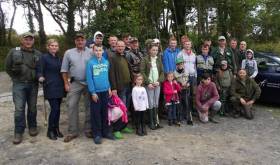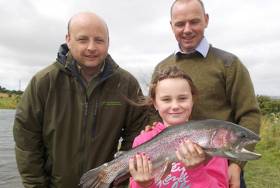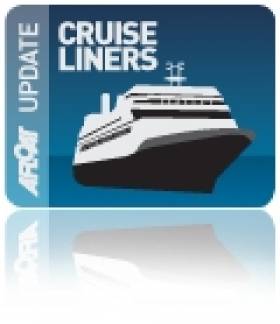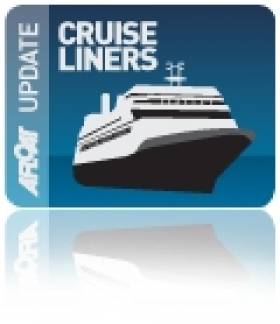Displaying items by tag: Boyne Valley
Young Anglers From Boyne Valley Enjoy Fishing Trip At Courtlough
#Angling - Members of the Boyne Valley Fishing Hub, which comprises clubs along the River Boyne with a focus on developing youth angling, enjoyed a fishing trip to Courtlough Trout Fishery earlier this month.
Some 30 experienced and novice anglers gave and attended lessons on fly fishing in the event, sponsored by Inland Fisheries Ireland (IFI), the Boyne Valley Fishing Hub and Courtlough Trout Fisheries Balbriggan, that was aimed at engaging potential young anglers in the Boyne Valley area.
Conditions on the day were difficult, but all anglers had success catching at least one fish each at the rainbow trout fishery, which consists of four acres of spring-fed lakes.
Topics covered during the fly fishing lessons included set-ups, fly choice and casting. Prizes were awarded at the end of the event to those who were particularly lucky on the day.
The event was facilitated as part of IFI’s Dublin Angling Initiative, which aims to promote, develop and improve angling in the greater Dublin area.
During the summer months, young people from national and secondary schools, summer projects and youth services are taken out on fishing courses.
To date, thousands of young people have been introduced to sea, coarse and game angling and the initiative has been a catalyst in setting up fishing clubs for many of these young people.
“It was fantastic to see so many anglers of different ages from Boyne Valley Fishing Hub take part in this trip," said Dublin Angling Initiative co-ordinator Oisin Cahill.
"Angling can be enjoyed at any age or ability and we are always welcoming young people who might be interested to consider trying it out."
Cahill added that the Dublin Angling Initiative "also engages young people around important issues such as conservation and the protection of our natural resources, which includes our fisheries.
"We hope this learning around biodiversity protection is something that will stay with them for the rest of their lives. We need to start engaging communities on these issues and getting the public out there to see what it is all about is a vital first step.”
For more on the Dublin Angling Initiative, visit www.fisheriesireland.ie or contact Oisin Cahill at [email protected]. For more information on Courtlough Trout Fisheries, contact Garrett on 0872712704. The Boyne Valley Fishing Hub can be found on Facebook HERE.
Young Anglers from Boyne Valley Enjoy Fishing Trip
Members of the Boyne Valley Fishing Hub recently enjoyed a fishing trip to Courtlough Trout Fishery. Almost 30 people took part in the event with experienced and novice anglers giving and attending lessons on fly fishing. The event, which was sponsored by Inland Fisheries Ireland, the Boyne Valley Fishing Hub and Courtlough Trout Fisheries Balbriggan, was aimed at engaging potential young anglers in the Boyne Valley Area.
Conditions on the day were difficult however all anglers had success catching at least one fish each at the rainbow trout fishery which consists of four acres of spring fed lakes. Topics covered during the fly fishing lessons included fly fishing set ups, fly choice and casting. Prizes were awarded at the end of the event to those who were particularly lucky on the day.
The event was facilitated as part of Inland Fisheries Ireland’s Dublin Angling Initiative which aims to promote, develop and improve angling in the greater Dublin area. During the summer months, young people from national and secondary schools, summer projects and youth services are taken out on fishing courses. To date, thousands of young people have been introduced to sea, coarse and game angling and the initiative has been a catalyst in setting up fishing clubs for many of these young people.
Oisin Cahill, Coordinator of the Dublin Angling Initiative at Inland Fisheries Ireland said: “It was fantastic to see so many anglers of different ages from Boyne Valley Fishing Hub take part in this trip. The Dublin Angling Initiative offers young people an opportunity to try out angling as a pursuit. Angling can be enjoyed at any age or ability and we are always welcoming young people who might be interested to consider trying it out.
The Dublin Angling Initiative also engages young people around important issues such as conservation and the protection of our natural resources, which includes our fisheries. We hope this learning around biodiversity protection is something that will stay with them for the rest of their lives. We need to start engaging communities on these issues and getting the public out there to see what it is all about is a vital first step.”
The Dublin Angling Initiative welcomes enquiries from all groups or individuals interested in its programmes and services. For further information, visit www.fisheriesireland.ie or contact Oisin Cahill, Dublin Angling Initiative Co-Coordinator by emailing [email protected] .
The Boyne Valley Fishing Hub is made up of clubs along the River Boyne including Navan, Trim and Bective with a focus on developing youth angling. For more information, visit the Boyne Valley Fishing Hub Facebook Page: https://www.facebook.com/groups/boynevalleyfishinghub/. For more information on Courtlough Trout Fisheries, contact Garrett on 0872712704.
Historic First as Cruiseship Calls to Drogheda Port
#DROGHEDA CRUISE CALL – The first ever cruiseship to visit Drogheda Port was welcomed this morning as Noble Caledonia' 122 passenger Clipper Adventurer (1975/ 4,367grt) entered the mouth of the Boyne, writes Jehan Ashmore.
Onlookers came out to view the historic arrival of the 101m long vessel which normally cruises in polar waters, either Antarctica or the Arctic. She berthed at Tom Roe Terminal, downriver from the older town-centre quays, having set off from Cork earlier this month on a 10-day circumnavigation cruise of Ireland.
On board the ice-strengthened exhibition vessel were American and Canadian passengers who were on the cruise organised by Adventure Canada, in association with Royal Canadian Geographical Society. Prices for the cruise which featured a varied lecture programme started from $3,995 dollars.
Facilities include a main lounge, bar, clipper club, library/card room, gymnasium and gift shop and throughout the intimate vessel, she sports plenty of varnished wood, brass, and timber lined decks. The new outside cabins have lower beds and private facilities in addition each with window view.
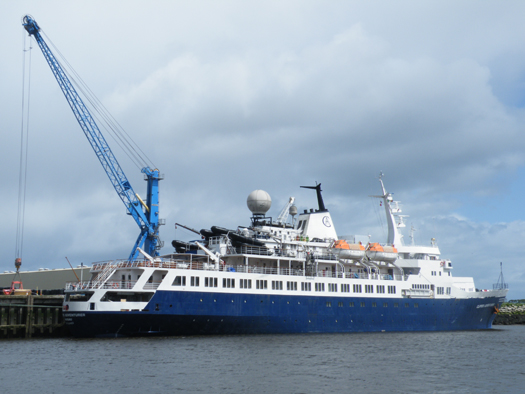
M.V. Clipper Adventurer moored alongside Tom Roes Terminal, Drogheda Port.
Photo: Jehan Ashmore
It is estimated the passenger spend generated from the cruise to the Boyne Valley is €60,000, the windfall will be a boost to the local economy. On foot of this the Drogheda Port Company has been in dialogue with a number of interested parties to build the brand and grow cruise business tourism in the region.
A small cruiseship such as Clipper Adventurer offers a more 'boutique' style of operation, in that she calls to more isolated destinations compared to the really large cruiseships. Among the ports of call on this Irish cruise they were to Kinsale, Dingle, Cliffs of Moher, Aran Islands, Westport and Tory Island.
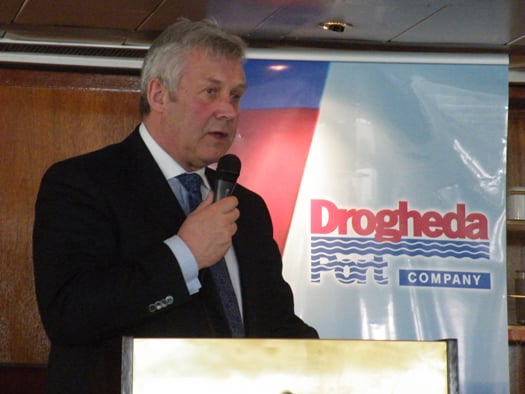
Minister of State Fergus O'Dowd speaking at a reception on board Clipper Adventurer to mark the historic cruise call visit
Where there are no port berthing facilities, passengers use instead a fleet of the vessels zodiacs which whisk them ashore to make excursions. Today her passengers disembarked to take a coach tour to the world famous visitor attractions along the Boyne Valley, before flying out of Dublin airport.
Not only is the cruise call a first for Drogheda Port but where a fly-cruise option is made available and also in reverse as the crew of the Clipper Adventurer are to welcome this evening more passengers flying in from Denmark. These passengers are to embark on a 6-day cruise of the Scottish Isles, terminating at Lerwick. The cruise is organised by Copenhagen based Albratros Tours.
Drogheda Port to Become New Cruiseship Destination
#CRUISE LINERS- In a first for Drogheda Port, the cruiseship, Clipper Adventurer (1975/4,367grt) is to call next May, and will represent a new business to the port as part of its circumnavigation of the island of Ireland, writes Jehan Ashmore.
The 101m long vessel will bring 236 American and Canadian visitors and a 65 crew, on a cruise organised by Adventure Canada, in association with Royal Canadian Geographical Society.
During the 10-day circumnavigation, the vessel will make calls to the Co. Louth port with passengers touring the Boyne Valley, The Skelligs, Aran Islands, the Gardens on Garnish at Glengariff and Tory Island. They will take in the history, archaeology, bird and marine life, culture, and Irish music in addition to a lecture programme from an on board team.
"With its downtown location, Drogheda Port is perfect for us," says Matthew Swan, president of Adventure Canada.
Last year, Swan visited Drogheda to conduct research for the cruise trip around Ireland. "I heard about your Graffiti and Samba Festivals before coming to town. It seemed like my kind of place, I'm definitely coming back for the Samba event."
Nessa Lally of Drogheda Port commented on the launch of the port as a new cruise destination: "Drogheda Port Company is pleased to announce the inaugural visit of the Clipper Adventurer to our port. This is the beginning of something special for Drogheda and the Boyne Valley.
The area has tremendous potential as a regular cruise destination with world class and potential world class attractions such as Newgrange, Slane Castle, Beaulieu House, the Battle of the Boyne site, the Hill of Tara and medieval Drogheda town itself, to mention just a few.
We will very much welcome the Clipper Adventurer and its passengers to our port and town and intend to give them a memorable visit to our locality. The port company has also commenced a dialogue with a number of interested parties to build and brand a full local itinerary for attracting and growing cruise business and tourism."
In the same month of the inaugural cruise, Drogheda will host a second cruise also by Clipper Adventurer, with Danish passengers organized through Copenhagen-based tour operator, Albatros Travel. They will undertake a 10-day Irish and Scottish itinerary that finishes in Bergen, Norway.
Clipper Adventurer is an exploration vessel which otherwise is often found cruising in polar waters, either Antarctica or the Arctic from Spitsbergen through Iceland, Greenland and Canada's Northwest Passage.
Over the last decade she has called to several Irish ports to include a once-off call to Arklow, where the Serbian-built vessel anchored offshore.


























